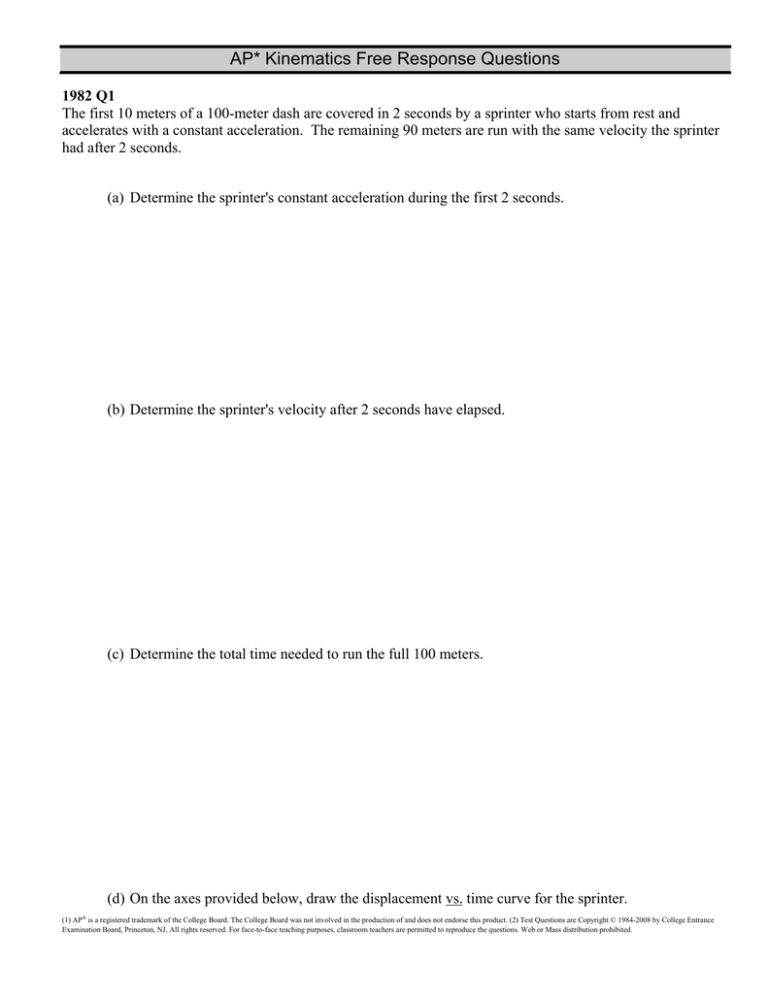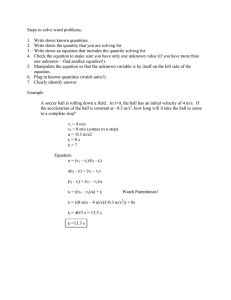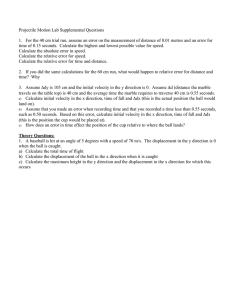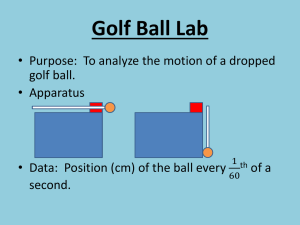
AP* Kinematics Free Response Questions
1982 Q1
The first 10 meters of a 100-meter dash are covered in 2 seconds by a sprinter who starts from rest and
accelerates with a constant acceleration. The remaining 90 meters are run with the same velocity the sprinter
had after 2 seconds.
(a) Determine the sprinter's constant acceleration during the first 2 seconds.
(b) Determine the sprinter's velocity after 2 seconds have elapsed.
(c) Determine the total time needed to run the full 100 meters.
(d) On the axes provided below, draw the displacement vs. time curve for the sprinter.
(1) AP® is a registered trademark of the College Board. The College Board was not involved in the production of and does not endorse this product. (2) Test Questions are Copyright © 1984-2008 by College Entrance
Examination Board, Princeton, NJ. All rights reserved. For face-to-face teaching purposes, classroom teachers are permitted to reproduce the questions. Web or Mass distribution prohibited.
AP* Kinematics Free Response Questions
page 2
AP* Kinematics Free Response Questions
page 3
1997 Q1
A 0.20 kg object moves along a straight line. The net force acting on the object varies with the object's
displacement as shown in the graph above. The object starts from rest at displacement x =0 and time t = 0 and
is displaced a distance of 20 m. Determine each of the following.
(a) The acceleration of the particle when its displacement x is 6 m.
(b) The time taken for the object to be displaced the first 12 m.
(c) The amount of work done by the net force in displacing the object the first 12 m.
AP* Kinematics Free Response Questions
page 4
(d) The speed of the object at displacement x = 12 m.
(e) The final speed of the object at displacement x = 20 m.
(f) The change in the momentum of the object as it is displaced from x = 12 m to x = 20 m
AP* Kinematics Free Response Questions
2005 Q1 (10 points)
The vertical position of an elevator as a function of time is shown above.
(a) On the grid below, graph the velocity of the elevator as a function of time.
page 5
AP* Kinematics Free Response Questions
page 6
(b)
i.
Calculate the average acceleration for the time period t = 8 s to t = 10 s.
ii.
On the box below that represents the elevator, draw a vector to represent the direction of this
average acceleration.
(c) Suppose that there is a passenger of mass 70 kg in the elevator. Calculate the apparent weight of the
passenger at time t = 4 s.
AP* Kinematics Free Response Questions
page 7
1998 Q6 (10 points)
A heavy ball swings at the end of a string as shown above, with negligible air resistance. Point P is the lowest
point reached by the ball in its motion, and point Q is one of the two highest points.
a. On the following diagrams draw and label vectors that could represent the velocity and acceleration of
the ball at points P and Q. If a vector is zero, explicitly state this fact. The dashed lines indicate
horizontal and vertical directions.
i.
Point P
ii.
Point Q
AP* Kinematics Free Response Questions
page 8
b. After several swings, the string breaks. The mass of the string and air resistance are negligible. On the
following diagrams, sketch the path of the ball if the break occurs when the ball is at point P or point
Q. In each case, briefly describe the motion of the ball after the break.
i.
Point P
ii.
Point Q
AP* Kinematics Free Response Questions
page 9
1994 Q1
A ball of mass 0.5 kilogram, initially at rest, is kicked directly toward a fence from a point 32 meters away, as
shown above. The velocity of the ball as it leaves the kicker's foot is 20 meters per second at an angle of 37°
above the horizontal. The top of the fence is 2.5 meters high. The kicker's foot is in contact with the ball for
0.05 second. The ball hits nothing while in flight and air resistance is negligible.
a. Determine the magnitude of the average net force exerted on the ball during the kick.
b. Determine the time it takes for the ball to reach the plane of the fence.
c. Will the ball hit the fence? If so, how far below the top of the fence will it hit? If not, how far above
the top of the fence will it pass?
AP* Kinematics Free Response Questions
page 10
d. On the axes below, sketch the horizontal and vertical components of the velocity of the ball as
functions of time until the ball reaches the plane of the fence.



